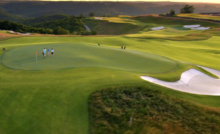State of golf course design and development
With this month’s national elections culminating 18 months of campaigning and considerable anticipation to the direction the United States shall move forward, I thought it is only appropriate to discuss the current state of golf course design and development.
Historically it is quite evident new golf course design and construction in the United States has been dictated by the economic conditions. Approximately 110 new courses per year were being constructed annually in the 1920’s. With the Depression came a drop in new construction to 30 courses by 1934. Annual course development maintained this level until 1952 when the U.S. post war economy began to flourish.
In 1960, 186 courses were built and the boom continued for nearly 10 years, peaking in 1968 with 220 new courses. As the interest rates climbed in the late 1960s, course development again began to slow. The fuel crisis in 1974 stopped many proposed facilities, and by 1978 only 58 new courses were completed. Interest rates skyrocketed to double-digit numbers peaking in l981, with an average of about 60 new courses a year coming online.
New course growth began to steadily grow after 1984 with our GNP and a steadily declining prime interest rate. In 1986, the National Golf Foundation proclaimed the U.S. needed to build a course a day to keep up with demand. It seems the industry heeded this advice and tried. In 1991, 190 new courses opened climbing to 242 and 284 respectively for 2000 and 2001.
The 9/11 attack on the World Trade Center staggered the U.S. travel and resort industry with significant economic repercussions. In 2002, 220 courses opened, some 64 less than the year before, starting the third decline in U.S. course development since the turn of the 20th Century. Through 2011, we have seen a 10-year free fall to only 19 courses completed in 2011. There is no question the unsettled stock market of the early 2000’s and the recession contributed to the downturn.
However, contrary to the 1980s dip when there was an inverse correlation between climbing prime interest rates and course construction, since the year 2000, interest rates have continuously declined, as has golf course construction. It is recognized in the industry play has flattened and fallen, creating a lack of demand in many geographical areas touting new facilities. I would suggest many of the disappearing rounds can be attributed to the lagging economy and less disposable income. There is currently a supply and demand imbalance straining many course’s operations budgets with lower rates and less rounds.
In the latest course construction boom, we also saw new course costs nearly triple over some 10-15 years, necessitating the same with cost to play. Quite simply, the market does not support the higher green fee structures, placing many newer facilities with substantial debt in jeopardy.
The demographic age group driving the growth of golf in the last 20 years has been the Baby Boomer. As they are now retiring, their profile is changing, confounding many in the industry.
Decreasing rounds, more courses, higher debt, and less income is having its effect. Annual course closures have continually climbed from 38 in 2002, to 157 in 2011, for a total of 1,037 closures; 46 less than the 1,083 opened during the same period, basically zero net growth of new golf courses over the last ten years.
History may well be the best vision as to how to plot the resurgence of golf development. The first new course construction cycle in the 1900s time period from peak growth, to the bottom and returning to peak growth was from 1925 to 1966, or some 40 years, and the second cycle from 1966 to 1996, or 30 years duration. As it seems there are more issues in the golf industry and U.S. economy affecting the current downtown than the 1966 to 1996 cycle, I think we can easily see a 40-year cycle, suggesting we have another ten years of market adjustment prior to seeing substantial growth. Ten years from now when the Baby Boomers have retired, are no longer the driving force in the player pool market and the younger generations have formulated different lifestyles, it becomes very difficult to predict how big the next upturn might be.
It appears the foreseeable future of course development is bleak. If history is accurate, it will be another 10 years until we see an upturn and then another 20 to an unknown peak. As a golf course architect, future commissions for designs of new courses are disconcerting when you consider the American Society of Golf Course Architects has grown from 35 in 1968 when 221 courses opened in the U.S., to a 2011 membership of 182 when 19 new courses opened. Probably the same may be said for many specialists involved in golf course development including golf course construction contractors.
Currently we are seeing courses strive to cut operating expenses to survive. The golf course maintenance budget is usually the first target. The movement in the turf industry is fast and firm versus the traditional U.S. course expectation for perfection of course conditions. The return of the “green keeper” or working superintendent is becoming more and more prevalent with staff labor reductions.
To accomplish more with less mowing is being simplified. Pull gang reel and rotary units are making a come back. As mowing heights and step cuts are eliminated, the larger and wider mowing units achieve maximum production per operator with minimal effect to playing conditions. Courses are establishing out-of-play areas and allowing them to grow to reduce regular mowing and fertilizing costs. Riding greens in lieu of walking, whether on a daily basis or several times a week is becoming a necessity. Speed and height of cut are dictated by budget constraints more than player desires.
These efficiencies further translate to renovations for more maintainable
features. In the case of bunkers, fewer, less area, flatter and easier to take care of. Greens are being scrutinized to cut costs with size, adjustment to contour and more manageable turf. Irrigation systems are returning to less and bigger heads with simpler controls for less expensive renovations.
The golf industry is focused on growing the game in many directions. Most recently the PGA of America and American Society of Golf Course Architects unveiled “First Links,” a program providing grants to courses for an on-site architect review for suggestions on how to modify the course to specifically encourage and welcome new players.
When the U.S. economy stabilizes and again starts to grow there will be redesign and rebuilding opportunities. Courses will make capital improvements. In many cases the improvements will be driven by the need to improve the economic efficiency of the facility. Architects’ and contractors’ ingenuity will be tested to formulate innovative if not simpler solutions with affordable construction techniques.
NOTE: Statistics taken from the National Golf Foundation which may vary publication to publication. The new courses per year are noted as 18-hole equivalents. The statistics are used to suggest trends more so than exact milestones.
With 40-years of golf course designs throughout the world, Denis Griffiths and Associates has firmly established a reputation for solid, challenging and enjoyable courses. Currently the firm is managing operations of Old Union Golf Course and consulting with clients in various capacities. Denis Griffiths holds a degree in landscape architecture from Iowa State University and is former president of the American Society of Golf Course Architects. 770.867.4480 • denis@dgagolf.com
Recent Posts
One of the Biggest Jobs in Golf
When Rory McIlroy finally slipped into the Green Jacket on Sunday, April 13, 2025, after…
Audubon International Marks Earth Day In Growth Mode
As the world celebrates Earth Day on April 22, Audubon International – the environmentally focused non-profit…
Help keep golf sustainable by bidding in GCSAA’s Rounds 4 Research online auction
In celebration of Earth Day, you can help fund the research that advances golf’s environmental…
Five Cabot Golf Courses Place in Golfweek’s Prestigious 2025 Top 100 International Courses List
Cabot, a developer and operator of luxury resort and residential golf destinations, is proud to…
Champion Hills Rebuilds with Heart: A Story of Resilience and Restoration
When Hurricane Helene swept through in late September 2024, Champion Hills Golf Club faced a…
Discover the New Graves Golf Club: A Game-Changing Facility in Edmond, OK
Graves Golf Club, the much-anticipated golf and training destination founded by celebrated instructors Tim and…



